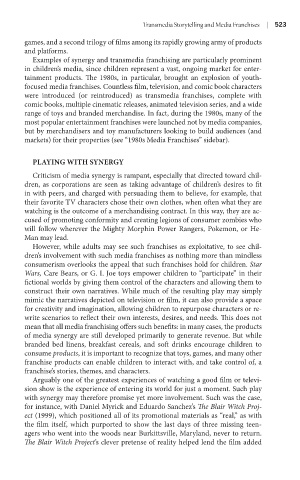Page 544 - Battleground The Media Volume 1 and 2
P. 544
Transmed a Storytell ng and Med a Franch ses |
games, and a second trilogy of films among its rapidly growing army of products
and platforms.
Examples of synergy and transmedia franchising are particularly prominent
in children’s media, since children represent a vast, ongoing market for enter-
tainment products. The 1980s, in particular, brought an explosion of youth-
focused media franchises. Countless film, television, and comic book characters
were introduced (or reintroduced) as transmedia franchises, complete with
comic books, multiple cinematic releases, animated television series, and a wide
range of toys and branded merchandise. In fact, during the 1980s, many of the
most popular entertainment franchises were launched not by media companies,
but by merchandisers and toy manufacturers looking to build audiences (and
markets) for their properties (see “1980s Media Franchises” sidebar).
PLaying wiTh synErgy
Criticism of media synergy is rampant, especially that directed toward chil-
dren, as corporations are seen as taking advantage of children’s desires to fit
in with peers, and charged with persuading them to believe, for example, that
their favorite TV characters chose their own clothes, when often what they are
watching is the outcome of a merchandising contract. In this way, they are ac-
cused of promoting conformity and creating legions of consumer zombies who
will follow wherever the Mighty Morphin Power Rangers, Pokemon, or He-
Man may lead.
However, while adults may see such franchises as exploitative, to see chil-
dren’s involvement with such media franchises as nothing more than mindless
consumerism overlooks the appeal that such franchises hold for children. Star
Wars, Care Bears, or G. I. Joe toys empower children to “participate” in their
fictional worlds by giving them control of the characters and allowing them to
construct their own narratives. While much of the resulting play may simply
mimic the narratives depicted on television or film, it can also provide a space
for creativity and imagination, allowing children to repurpose characters or re-
write scenarios to reflect their own interests, desires, and needs. This does not
mean that all media franchising offers such benefits: in many cases, the products
of media synergy are still developed primarily to generate revenue. But while
branded bed linens, breakfast cereals, and soft drinks encourage children to
consume products, it is important to recognize that toys, games, and many other
franchise products can enable children to interact with, and take control of, a
franchise’s stories, themes, and characters.
Arguably one of the greatest experiences of watching a good film or televi-
sion show is the experience of entering its world for just a moment. Such play
with synergy may therefore promise yet more involvement. Such was the case,
for instance, with Daniel Myrick and Eduardo Sanchez’s The Blair Witch Proj-
ect (1999), which positioned all of its promotional materials as “real,” as with
the film itself, which purported to show the last days of three missing teen-
agers who went into the woods near Burkittsville, Maryland, never to return.
The Blair Witch Project’s clever pretense of reality helped lend the film added

